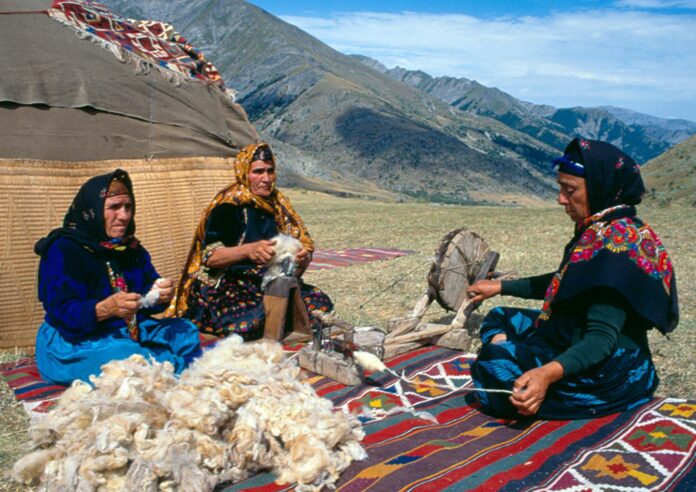The after effects of the pandemic due to the coronavirus has had such a negative impact on the tourism industry. After almost two years of travel restrictions, it has made us wish more than ever to go somewhere, anywhere, to create new impressions, experience adventure again, even more than we did in the pre-pandemic period. The good news, however, is that you can get a memorable experience without the need to travel far. Sometimes you don’t even need to leave the city you live in. Should you find yourself in Azerbaijan, then you are really quite fortunate, considering its rich cultural heritage and many beautiful traditions. A list of recommendations below will help you to decide what to see, feel, taste and touch in Baku and the other regions of the country. All the elements on this list are part of the UNESCO Intangible Cultural Heritage list, which identifies their significance to the world, not only for Azerbaijani people but also for the international tourist.
BY ELENA KOSOLAPOVA
AZERI OBSERVER STAFF WRITER
Go back in time with traditional music
Mugham is one of the main genres of traditional Azerbaijani folk music, characterized by a large degree of improvisation. This musical genre shares artistic characteristics with the Iraqi Maqam, the Persian Radif and the Turkish Makams. Mugham was shaped in Azerbaijan in the period of the “Muslim Renaissance” in the 12th-13th centuries when many great poets arose. Their ghazals (short poems), and the poetry of later writers, formed the basis of Mugham.
Contemporary Mugham pieces reflect different periods of Azerbaijan’s history and its contacts with the neighboring nations. They feature a male or female singer accompanied by musicians playing traditional instruments, such as the tar (a long-neck lute), the kamancha (a four-string spiked fiddle) and the daf (a type of large tambourine). Since Mugham cannot be transcribed in a fixed form, multiple versions are transmitted by masters.
The best venue to listen to Mugham is Baku’s International Mugham Center, which was built as a place to host, promote, preserve and popularize this musical genre. Designed in the form of two tars, this stylish modern building is located on Baku Boulevard in a very favored central location.
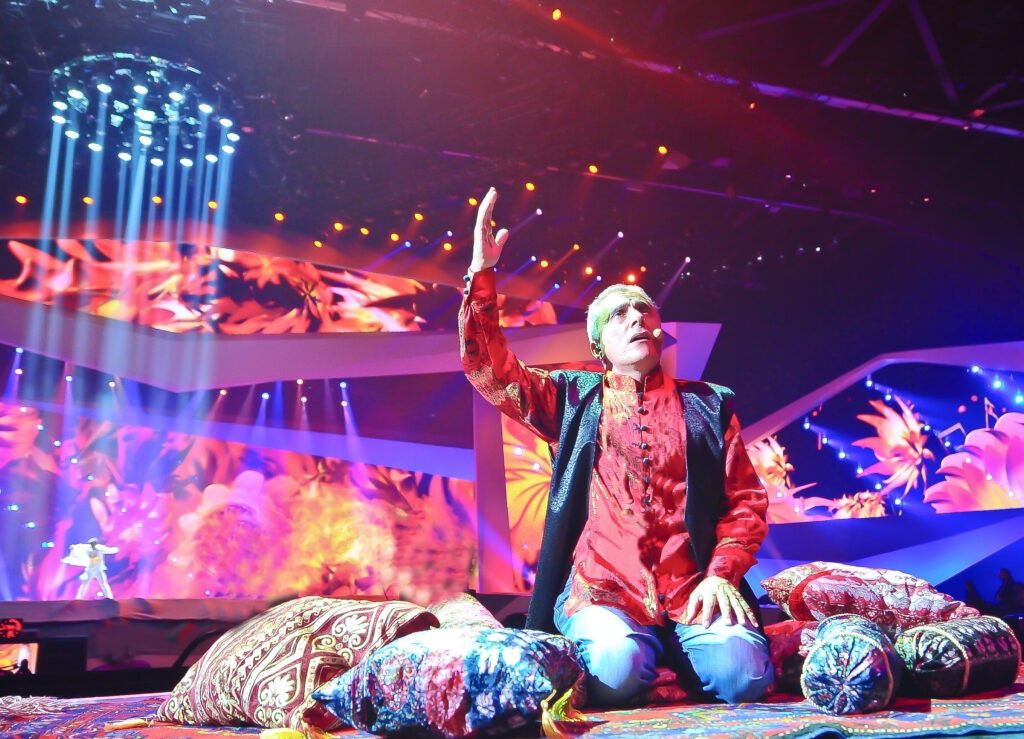
Meet Azerbaijani ashiqs, the national performers
The art of Azerbaijani ashiqs combines poetry, storytelling, dance, vocal, and instrumental music into a traditional performance art that stands as a symbol of Azerbaijani culture. Possessing a variety of artistic skills, ashiqs create a complete artistic image which allows them to convey their thoughts and emotions through the music. Their songs are often accompanied by the balaban (small wind instrument) and wind ensembles, but the main musical instrument of the ashiq music is the saz (traditional Azerbaijani stringed musical instrument).
The art is considered an emblem of national identity and the guardian of Azerbaijani language, literature and music. Ashiqs also help to promote cultural exchange and dialogue: Kurds, Lezgins, Talishes, Tats and other ethnic groups living in the country often perform this art, spreading their poems and songs wide across the region.
Nowadays ashiqs perform at weddings, friendly parties and festive events throughout the Caucasus and appear on concert stages, radio and television, sometimes blending classical melodies with contemporary ones as they continue to recreate their repertoire. Some elements of the ashiq art are reflected even in Azerbaijani classical music, such as Koroghlu opera by Uzeyir Hajibeyli, and the Third Symphony by Gara Garayev.
Learn carpet-weaving techniques
Azerbaijan produces almost all types of carpets and rugs that exist in the world: wool, silk, gold and silver threads, pile and pileless carpets, etc. The distinguishing feature of the Azerbaijani carpet is the high density of nodes (from 1,600 to 4,900 per square decimeter), which is why their lifespan is from 300 to 500 years. It is a symbol of luxury, gentility and refined taste. For centuries, Azerbaijan remained one of the trendsetters for carpets. Their artistic properties and high quality were always well renowned by Arab, European and Russian travelers.
Carpet making is a family tradition passed down from generation to generation, through word of mouth, and of course, thorough practice. In the past carpets were woven in almost every Azerbaijani house, and carpet was part of everyday life. People rested, ate and received guests on them for centuries. Nowadays carpets are still widely used for home furniture and decoration, and special carpets are woven for medical treatment, wedding ceremonies, the birth of a child, mourning rituals and prayer.
The Carpet Museum, situated on the Seaside Boulevard, will teach you more about carpet weaving traditions in Azerbaijan. The building shaped like a rolled-up rug is one of Baku’s modern architectural wonders, and contains a unique collection of over 6,000 carpets. Strolling around the exquisitely curated exhibits, you will also discover how carpets are made through live demonstrations, how they have evolved throughout the centuries and how they differ from the many different carpet-weaving schools.
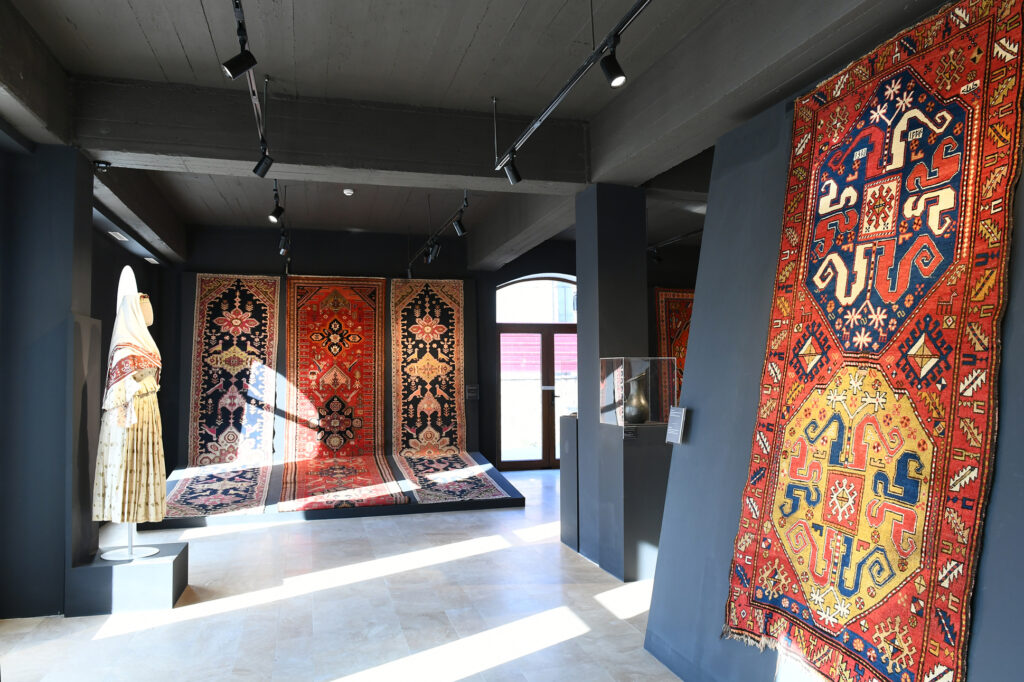
Enjoy music played on traditional instruments
The Tar is a long-necked plucked lute, traditionally crafted and performed in communities throughout Azerbaijan. Considered by many to be the country’s leading musical instrument, it features alone or with other instruments in numerous traditional musical styles. For example, the aforementioned Azerbaijan national music Mugham cannot be imagined without the tar.
Tar performance has an essential place in weddings and different social gatherings, festive events and public concerts. Players teach their skills to young people within their community through demonstration, and at music schools. It is also one of the few national instruments for which famous Azerbaijani composers wrote pieces, concerts and operas.
The art of crafting and playing the Kamancha, a bowed string instrument, has existed for over 1,000 years. It constitutes a major element of classical and folkloric music, and performances occupy a central place in a wide number of social and cultural gatherings. Through their music, performers convey many themes, from the mythological to the gnostic and the comic. In many folk orchestras and groups, such as S. Rustamov Folk Instruments Orchestra and many others, kamancha is used as a lead instrument.
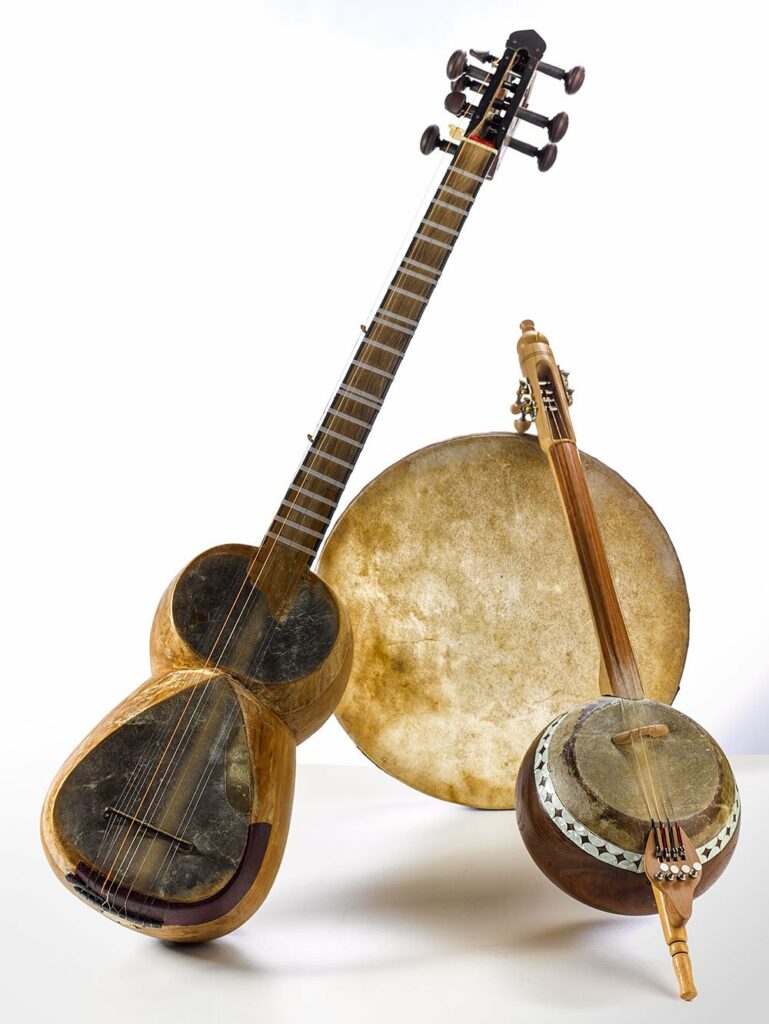
Be impressed by the grace of the Karabakh horse
Chovqan, an ancient horse-riding game, is the predecessor of modern polo. Historians believe that Chovqan was born in the middle of the first millennium and was popular in a broad region covering Azerbaijan, Iran, Turkey, Central Asia and neighboring countries for several centuries. Historically in Azerbaijan, Chovqan was widely played by the aristocracy and members of Shah’s family. In this game, two teams of five riders mounted on horses compete on a flat, grassy field. The game required specially trained, short but fast horses, which is why it was so popular in Karabakh where breeders concentrated on producing the best breeds of horses, including the famous Karabakh breed. Chovqan strengthens the feelings of identity rooted in nomadic culture and linked to the perception of the horse as an integral part of everyday life. The players traditionally wear large hats, long tight-fitting coats with a high waist, and special trousers, socks and shoes. Usually folk music is played using an instrumental called a janghi, during the game. People of all ages come to watch this traditional game and to support their teams. The specific rules, skills and techniques of Chovqan are passed down from experienced players to beginners through collective training. In the last few decades, the practice of Chovqan has weakened due to a loss of interest among the youth, combined with urbanization and migration, leading to a shortage of players, trainers and Karabakh horses. Today Chovdan can be seen mainly at different festivals throughout the country.

Decorate yourself with a silk Kelaghayi
Thin, almost weightless and with colors able to compete with a rainbow, Azerbaijani silk scarves called kelaghayis have almost a 1,500-year history. Kelaghayis are so light and elegant, you could pass one through a ring, were worn by all Azerbaijani women, bright ones by the young and dark ones by the old. Usually they were placed on top of the headdress or wrapped around the head as a turban.
The art of Kelaghayi production is rooted in traditions found along the Great Silk Road. Weavers would choose thin silk threads from sericulture producers, weave the fabrics on looms, then would boil and dry them to make square-shaped cloths. Using vegetable substances, masters would then dye the cloths with various colors and decorate them with patterns using wooden stamps, covered with solutions made from rosin, paraffin and solid oil. The colors of these headscarves have symbolic meanings and are often tied to specific social occasions, such as weddings, mourning ceremonies, daily activities and celebrations. The art of Kelaghayi making, is transmitted through non-formal apprenticeship only, and is primarily a family occupation. Each family has its own stylistic features and patterns of decoration.
Despite the fact that today kelaghayis are still produced in many regions, this art is most common in the city of Basgal, 165 km north-west of Baku, and in the city of Sheki, located 320 km away in the same direction, where you can buy them in many gift shops. People who want to know more about the significant role of kelaghayis in the life of Azerbaijani people should visit the Museum of Basgal or National Museums such as the Museum of History of Azerbaijan and the Museum of Art of Azerbaijan.

Acquire handmade copperware in Lahij
The village of Lahij located in one of the mountain valleys of the Greater Caucasus in the north of Azerbaijan, is famous for its coppersmiths. They have been living here since ancient times. The copper-smelting master coordinates the entire process and apprentices learn the necessary techniques while helping the master. The coppersmith-hammerer pumps the air into the ovens and hammers the smelted copper into thin plates. A craftsperson then polishes the hammered copper plates and decorates the ready copperware with engravings. This final stage of the process is particularly important as the designs used often have an environmental focus, reflecting the bearer’s traditional knowledge and cultural values. The master is also responsible for selling the copperware in the workshops and remunerating the work of the other craftspeople involved. For artisans, the tradition represents a major source of living and provides a strong sense of identity and community pride. To preserve this amazing city of craftsmen, Lahij was declared a state historical and cultural reserve of the 15th-19th centuries. Now it is a popular tourist destination full of workshops, gift shops, restaurants, medieval architecture and beautiful landscapes. Tourists coming here by a modern road still can see how masters forge a knife or make a dish from a copper sheet like they did several centuries ago.

Celebrate the New Year in spring
Novruz is one of the most important and favorite holidays of Azerbaijani people. It marks the arrival of spring and is celebrated on the vernal equinox, March 20-21 – the beginning of the astronomical New Year. The origin of Novruz dates back to ancient customs and rituals associated with sorcery, the cult of nature and fertility, as well as beliefs in nature’s decline and rise. The preparations for the holiday start at the end of February: during the month leading up to Novruz, every Tuesday is devoted to celebrating nature’s four elements consecutively: water, fire, earth, and air (or wind). In the evening, children put hats under neighbors’ doors and hide, waiting for the neighbors to fill the hats with holiday favors. After sunset, people gather in the streets to kindle bonfires, dance around them, and jump over them to cleanse their souls and ward off evil spirits.
When the holiday finally comes, the festivities last for several days. An important tradition practiced during this time is the gathering around the table, decorated with objects that symbolize purity, brightness, livelihood and wealth, and enjoying a special meal with loved ones. New clothes are worn and visits made to relatives, particularly the elderly and neighbors. Gifts are exchanged, especially for children.
Novruz is also the time for mass gatherings and festivals. Ashug and folk music concerts are held countrywide in this period. Ropewalkers demonstrate their skills, pehlevans (wrestlers) compete against each other, comedy performances are held on the streets. The holiday is also celebrated in other countries of the region such as Afghanistan, Iran, Kazakhstan, Kyrgyzstan, Tajikistan, Turkmenistan, Uzbekistan, etc.
Try healthy and light flatbread lavash
Lavash is a flatbread made from flour and water. It is an indispensable component of every Azerbaijani meal, and is served to the table along with other varieties of bread. Azerbaijanis like to have it for breakfast, traditionally spreading butter and cheese on it and rolling lavash into soft, delightful tubes, which are perfect with a cup of sweet tea or coffee. This flatbread also goes perfectly with traditional Azerbaijani kebabs, and is used in pilaf, and other dishes. Besides regular meals, flatbread is shared at important events such as weddings, births, funerals, various holidays and during prayer.
Lavash making is usually collective work in which all family members take part; in rural areas even friends and neighbors become involved. It carries intangible benefits for relationships. Families and friends get together, laugh and generally have fun. Lavash is baked in traditional ovens – tandir (an earth or stone oven in the ground), or, if it needs to be prepared thin – on sadj (a metal plate). Some archeological excavations have revealed tools for making lavash dated to the Bronze Age, which show that lavash preparation techniques have remained the same. Today, lavash is served at many local restaurants and can be bought in almost any supermarket throughout the country. Traditions of making flatbread similar to lavash also exist in other countries of the region: Iran, Turkey, Kazakhstan, Kyrgyzstan and others.
Savor the delicious taste of juicy dolma
Dolma is a traditional Azerbaijani meal in the form of small fillings wrapped in fresh or pre-cooked leaves of vine, dock, hornbeam or quince trees or stuffed into fruits and vegetables such as apple, pepper, tomato, eggplant, quince, gourd, pumpkin, cucumbers or mushrooms. For the stuffing, local communities most often use standard ingredients: meat, onion, rice (or peas) and spices. The name of this tradition originates from the shortened Turkic word “doldurma”, meaning “stuffed”. The meal is then cooked in clay pots, aluminum or copper caldrons called “qazan” and then shared within families or neighborhood communities. Depending on the surrounding environment, climate and season, communities use various methods, techniques and ingredients for the preparation of this traditional meal.
Transferred from generation to generation, the dolma making tradition is practiced and shared throughout Azerbaijan, and is perceived as a central culinary practice in all regions. It is served as a daily meal at home and on special occasions and gatherings, and expresses solidarity, respect and hospitality. You can try this delicious, wholesome and nutritious dish in any restaurant of national cuisine. Before the pandemic, Azerbaijan hosted several International Dolma festivals in the picturesque Northern region of Khachmaz.

Learn to dance Azerbaijani yalli
Yalli are group dances of Nakhchivan, based exclusively on collective performances. Typically, yalli are performed in a circle, chain or line, and involve elements of games, pantomime (bird or other animal imitations), physical exercises and movements. The community of the yalli dances consists of practicing dancers, who enact the dances either spontaneously or in a planned manner at various festivities and celebrations. Some variants of yalli bear a song-like character and are practiced by both women and men, while others are practiced by men only and imitate pastoralist games with some elements of butting animals. Yalli is still common at many wedding celebrations and other festivities in Azerbaijan, where everyone may find themselves invited to join a dance line and learn some basic steps.
Learn about the social lifestyle of nomadic Turkic peoples
The Book of Dede Qorqud is the most famous among the epic stories of the Oghuz Turks. The heroic legends, stories and tales of Dede Qorqud are shared and transmitted across the generations through oral expressions, performing arts, cultural codes and musical compositions. Dede Qorqud appears in each story as a legendary figure and wise individual, a sage of minstrels whose words, music and expressions of wisdom relate to traditions of birth, marriage and death. The element encompasses social, cultural and moral values significant to the social lifestyle of the nomadic Turkic peoples, such as heroism, dialogue, physical and spiritual wellness and unity as well as respect for nature, and contains profound knowledge about the history and culture of Turkic-speaking communities. It is practiced and sustained by the community concerned on a wide variety of occasions – from family events to national and international festivals.
Fill yourself with vitamins from the king of fruits
In Azerbaijan, the pomegranate is known as the king of fruits. Thanks to the country’s favorable climate and fertile soil, it is grown in almost all its regions. Symbolically, the pomegranate is associated with long-term productivity, abundance and is considered as a carrier of energy. Azerbaijani local legends viewed it as a symbol of love and passion, while religious people saw it as symbolizing eternity. Azerbaijan has a set of practices, knowledge, traditions and skills related to the fruit, which is used not only in a range of culinary contexts, but is also referred to in crafts, decorative arts, myths, storytelling and other creative outlets. The city of Goychay is considered the pomegranate capital of Azerbaijan because of the diversity of pomegranate grown in the region. Every October/November it hosts an annual festival that features Azerbaijani dishes containing pomegranates. The Pomegranate Festival or Nar Bayrami gathers the varieties of pomegranates grown in regions of the country. Along with degustation, a cultural parade is held with traditional Azerbaijani dances and Azerbaijani music at the festival. There are also several competitions, with participants competing to present the biggest pomegranate or eat the most pomegranates in a short time. So, don’t miss a chance to enrich your body with vitamins and have a good time!
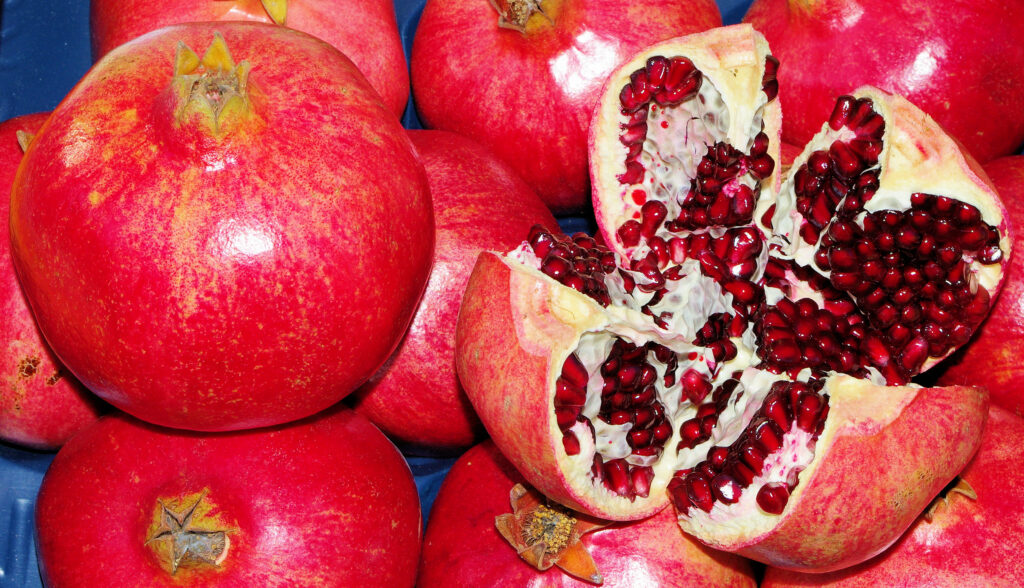
The art of miniature
The miniature is a type of two-dimensional artwork that involves the design and creation of small paintings on books, papier-mâché, rugs, textiles, walls, ceramics and other items using raw materials such as gold, silver and various organic substances. Representing beliefs, worldviews and lifestyles in a pictorial fashion, the patterns of the miniature gained a new character under the Islamic influence. This traditional craft is typically transmitted from mentor to apprentice as a part of non-formal education and considered to be an integral part of the society’s social and cultural identity. Though it has existed for centuries, it continues to develop. Traditional painting principles and techniques are preserved, but artists also bring individual creativity into the process. Wonderful examples of the art of miniature can be found in Azerbaijan National Art Museum and The Nizami Museum of Azerbaijani Literature in Baku.


